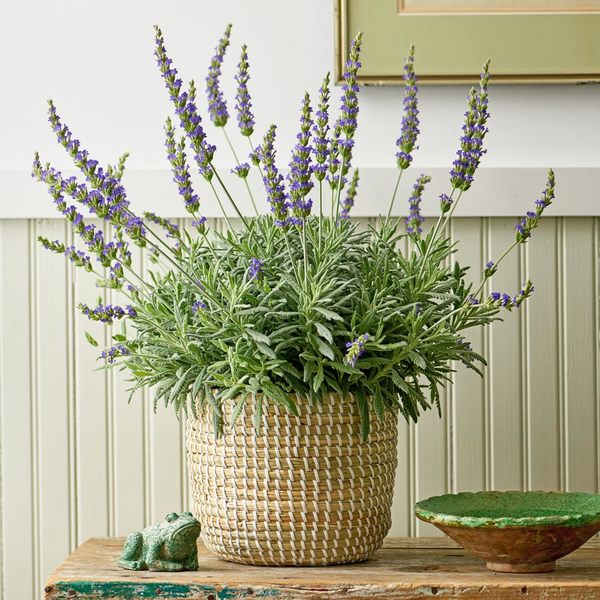
Lavandula ginginsii
Common name: Goodwin Creek
Fernleaf Lavender: A Gardener's Guide to Cultivating Lavandula Ginginsii
Lavandula ginginsii, known as Fernleaf Lavender, stands out with its unique, finely dissected foliage and fragrant purple flowers. This Mediterranean native is prized for its ornamental and aromatic qualities, perfect for herb gardens, borders, and containers.
Notable for its fern-like, silvery-green leaves and long-lasting, vibrant blooms.
Ideal for creating a sensory experience in gardens, with its appealing scent and texture.
Drought-tolerant once established, making it suitable for water-wise gardens.
Plant Care
Proper care is crucial for the thriving growth of Fernleaf Lavender.
Sunlight: Optimal growth and blooming are achieved in full sun, which is crucial for its health and vibrancy.
Soil: Best suited to well-drained, sandy or gravelly soil, as it is sensitive to overwatering and poor drainage conditions.
Watering: Moderate watering is recommended, with a focus on allowing the soil to dry out between waterings to avoid root rot.
Spacing: Space plants 18-24 inches apart to ensure adequate room for spread and proper air circulation, essential for plant health.
Planting and Propagation
Planting and propagating Fernleaf Lavender can add delightful fragrance and texture to your garden.
Plant in spring or early fall for best establishment.
Propagate by taking softwood cuttings in late spring or early summer.
Seeds can be sown but may not always come true to the parent plant.
Pests and Diseases
Fernleaf Lavender is generally pest-resistant and hardy, but some care is required.
Watch for common lavender pests like spittlebugs and aphids; treat as necessary.
Avoid root rot by ensuring good soil drainage.
Prone to fungal diseases in humid conditions; proper spacing and air circulation can help.
Feeding and Fertilizing
Initial Feeding: Apply a balanced, low-nitrogen fertilizer in early spring as new growth begins. Formulas specifically designed for flowering plants, such as a 5-10-10 NPK ratio, are ideal to encourage blooming while supporting healthy foliage development.
Soil Preparation: Before planting, incorporate organic matter or a well-balanced compost into the soil to improve drainage and fertility. Lavender thrives in well-drained, slightly alkaline soil.
Supplemental Feeding: If necessary, a mid-season application of a liquid fertilizer can be used to promote continued growth and flowering, especially in gardens with poor soil. However, it is crucial to avoid over-fertilization which can lead to excess foliage and fewer flowers.
pH Preference: Lavandula ginginsii prefers a slightly alkaline soil pH, around 6.5 to 7.5. Testing and adjusting the soil pH can enhance nutrient availability and overall plant health.
Avoid High Nitrogen Fertilizers: High levels of nitrogen can reduce flower production. Stick to a balanced or phosphorus-rich fertilizer to promote blooming.
Drought Tolerance: Once established, Goodwin Creek Grey Lavender is quite drought tolerant. Over-watering or excessive moisture can harm the plant, so ensure the soil has good drainage to prevent root rot.
This specific variety of lavender is known for its silver-grey foliage and deep violet-blue flowers, making it a stunning addition to any garden. It is particularly well-suited for use in xeriscaping, herb gardens, and as a border plant where its aromatic leaves and flowers can be fully appreciated.
Seasonal Care
Adjusting care according to the seasons will help your Fernleaf Lavender thrive.
In colder climates, provide some winter protection, such as mulching around the base.
Prune back in early spring to encourage bushy growth and more blooms.
Deadhead spent flowers to maintain a tidy appearance and encourage further blooming.
Plant Uses
Fernleaf Lavender is versatile in both its use and placement in the garden.
Excellent in herb gardens, rock gardens, and as a border plant.
The aromatic foliage and flowers are ideal for potpourri and lavender sachets.
Attracts bees and butterflies, making it a valuable addition to pollinator gardens.
Varieties and Cultivars
While Lavandula ginginsii is a distinct species, there are other lavender varieties for garden diversity.
Lavandula angustifolia, or English lavender, is known for its sweet fragrance.
Lavandula x intermedia, or Lavandin, offers larger plants with longer bloom stalks.
Select varieties based on your climate, as some lavenders are more cold-hardy than others.

Growing Tips and Tricks
Enhance your gardening experience with these additional tips for growing Fernleaf Lavender.
Prefers a sunny location with well-draining soil for optimal growth.
Tolerates heat and drought well, making it suitable for xeriscaping.
Regular trimming can prevent the plant from becoming woody and sparse.
Troubleshooting Common Problems
Addressing common issues early can keep your Fernleaf Lavender healthy and flourishing.
Yellowing leaves may indicate overwatering or poor drainage; adjust watering and improve soil conditions.
Leggy or sparse growth can indicate a need for more sun or a light pruning.
Protect from harsh winter conditions in colder zones to prevent dieback.










